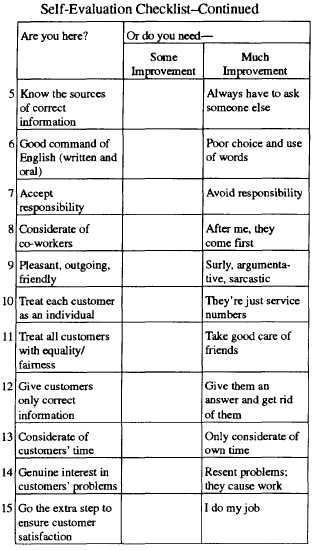| |
EVALUATING THE EXAMPLES
The examples provided in the following section of
this chapter provide scenarios that could be considered
to be realistic for the activity of a contact point. Each
scenario relates to a trait or an ability on the
self-evaluation checklist. Keep in mind that the
scenarios do not show a true overall view of contact
point operations or the performance of contact point
representatives.
The scenarios name specific ratings and contact
points; however, you should direct your evaluation
toward the person providing the service, NOT toward
the rating or the contact point. No attempt was made to
develop examples that could cover every possibility;
however, they do cover a range of attitudes and skills
that make the difference between good service and
marginally adequate service.
The purpose of this chapter is
actions and attitudes associated
to help you identify
with good service.
2-2
Therefore, none of the examples cover the first item on
the checklist, “Presents good personal appearance.”
Checklist items 2 through 6 relate more to the
requirements of your rating than to the face-to-face
skills needed at contact points. Therefore, the examples
emphasize the traits and abilities contained in items 7
through 15. These items deal with traits that affect the
way you respond to customer needs.
In evaluating the performance of the people
described in the examples, you are asked to assume two
roles: (1) the role of the customer and (2) the role of the
contact point representative.
ROLE OF THE CUSTOMER
The customers at your contact point do not see, and
are not particularly interested in, your total work load.
They see only your response to their needs at that
specific time. Thus, the customers’ opinion of your job
effectiveness may be as distorted as that described in
some of our scenarios, since both deal with only a brief
part of a day’s work. Some of the scenarios may not
provide enough detail to allow you to evaluate the
representative fairly. However, you must remember that
is also the basis on which your customer evaluates you.
ROLE OF THE CONTACT POINT
REPRESENTATIVE
In the role of the contact representative, you are
aware of the total work load and responsibilities of the
job. Because you have this broader base of knowledge
on which to make an evaluation, you may even justify
and excuse some of the representatives’ actions. In
evaluating the examples, don’t excuse actions because
of a misplaced sense of loyalty to your fellow workers.
Remember, you are responsible to all members of the
Navy, not just to those in your rating.
SCENARIOS
Each of the following scenarios, or cases, is
followed by a checklist of items you are to evaluate from
the information given. A brief critique following each
item points out the evidence on which you can make an
evaluation and suggests possible causes and improve-
ments.
You may find some similarities between the
attitudes shown in the examples and your own. That will
help you to identify traits and abilities you need to
develop or improve upon.
|

